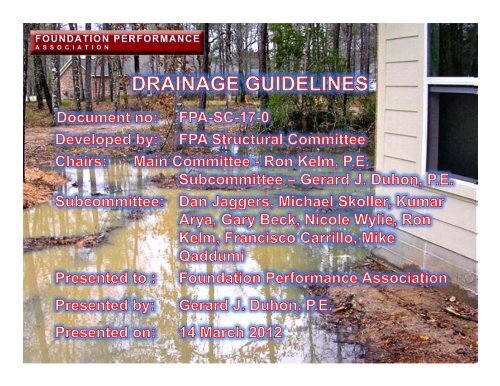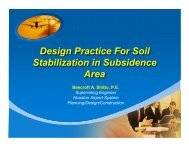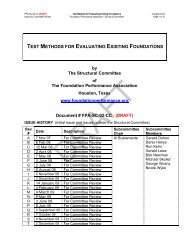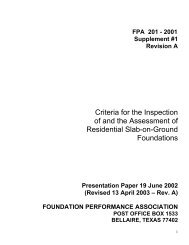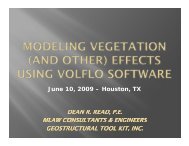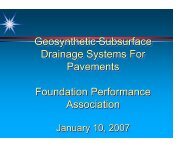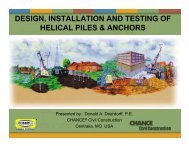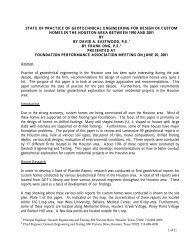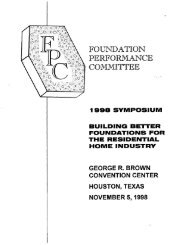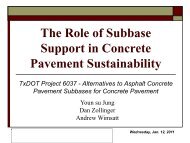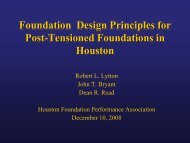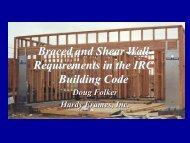Drainage Guidelines - Foundation Performance Association
Drainage Guidelines - Foundation Performance Association
Drainage Guidelines - Foundation Performance Association
Create successful ePaper yourself
Turn your PDF publications into a flip-book with our unique Google optimized e-Paper software.
WHO WAS INVOLVED?<br />
FPA-SC-17 Presentation 14 March 2012<br />
Francisco Carrillo, Mike Qaddumi, Michael Skoller –<br />
Knowledge of design of drainage systems<br />
Kumar Arya – Knowledge of infrastructure<br />
Gary Beck – Knowledge of drainage system design and<br />
environmental construction methods<br />
Dan Jaggers – Contracting experience, plumbing<br />
knowledge, drainage problem solving<br />
Ron Kelm, Nicole Wylie – Knowledge of drainage effects on<br />
foundations, soils, organization of document<br />
2
FPA-SC-17 Presentation 14 March 2012<br />
Gerard Duhon – Wrote rough draft of most sections of<br />
paper, performed research<br />
Mike Qaddumi – Provided conference room at Interfield for<br />
work on document<br />
Ed Fronapfel, Toshi Nobe, Steve Andras, Karl Breckon,<br />
Stephen Newberry, Ken Douglass, Steve Schilder - Peer<br />
reviewers with comments<br />
3
WHAT WAS DONE?<br />
FPA-SC-17 Presentation 14 March 2012<br />
Created a 45 page document, covering different<br />
drainage methods in use, to employ in<br />
residential and commercial construction to<br />
effect proper drainage, with consideration of the<br />
drainage on the environment and the<br />
foundation. Additional 160 pages of appended<br />
material.<br />
Does not cover irrigation for the sake of<br />
foundation performance.<br />
4
WHEN WAS IT DONE?<br />
FPA-SC-17 Presentation 14 March 2012<br />
• Sanctioned 25 March 2009<br />
• First meeting 7 October 2009<br />
• Met monthly for two years until submitted for<br />
peer review<br />
• Met bi-monthly after peer review<br />
• Involved 37 revisions<br />
• Published 5 March 2012<br />
5
WHY WAS IT DONE?<br />
FPA-SC-17 Presentation 14 March 2012<br />
• There was a lack of trustworthy information<br />
available in the literature and the internet<br />
which was comprehensive in scope and<br />
depth.<br />
• Especially, lack of reliable information on<br />
French drains.<br />
6
SECTIONS<br />
FPA-SC-17 Presentation 14 March 2012<br />
• TITLE<br />
• PREFACE<br />
• GLOSSARY<br />
• TABLE OF CONTENTS<br />
• INTRODUCTION<br />
• DRAINAGE<br />
• SOURCES<br />
• COLLECTION AND MANAGEMENT<br />
• DISPOSAL<br />
• DRAINAGE EFFECTS ON FOUNDATIONS<br />
• COMMON DRAINAGE PROBLEMS<br />
• SITE SOIL TYPES<br />
• REFERENCES<br />
7
FPA-SC-17 Presentation 14 March 2012<br />
Generally, drainage system write-ups were<br />
separated into sections:<br />
• General description<br />
• Purpose and application<br />
• Planning<br />
• Construction considerations<br />
• Maintenance<br />
<strong>Drainage</strong> effects write-up was separated into<br />
three soil types:<br />
• Clay<br />
• Silt<br />
• Sand<br />
8
FPA-SC-17 Presentation 14 March 2012<br />
PREFACE - LIMITATIONS<br />
• INTENDED AUDIENCE - persons seeking an<br />
understanding of the function of drainage and the<br />
proper construction to effect proper drainage in the<br />
vicinity of new and existing residential and low-rise<br />
building construction<br />
• SPECIFIC AUDIENCE - builders and contractors,<br />
owners, surveyors, foundation design engineers,<br />
geotechnical engineers, landscapers, landscape<br />
architects, civil engineers, and others<br />
• GEOGRAPHICAL - does not foresee geographical<br />
limitations on the use of this document<br />
9
GLOSSARY<br />
FPA-SC-17 Presentation 14 March 2012<br />
Found to be necessary due to unclear usage of terms.<br />
From the Introduction: Describing drainage involves<br />
using terms which may have two or more commonly used<br />
meanings, such as the word “grade”: 1) inclination with<br />
the horizon, and 2) the level at which the ground<br />
intersects the foundation of a building, and 3) the surface<br />
of the ground. Also consider the word “drain”: 1) verb, to<br />
draw off liquid, 2) noun, means (such as piping) by which<br />
liquid matter is drained, and 3) noun, a plumbing fixture<br />
that provides an exit point for waste water. Also, there are<br />
many local variations on terms used and there is little<br />
standardization of terms in the description of<br />
manufactured products.<br />
10
GLOSSARY – Continued<br />
FPA-SC-17 Presentation 14 March 2012<br />
An effort has been exerted in this paper to reduce the<br />
ambiguities in the use of drainage language, including a<br />
glossary, but the reader should be aware of the<br />
imprecision in the language and consider the context.<br />
There was much discussion about inclusion of terms,<br />
definition of terms, usage of terms, from the beginning to<br />
the end of the committee. 30 terms were defined.<br />
11
GLOSSARY - EXCERPT<br />
FPA-SC-17 Presentation 14 March 2012<br />
• Discharge – Exiting of water flow from a drainage<br />
device or conduit.<br />
• Disposal, dispose, disposal point – The discharge of<br />
water flow to a specific site. Disposal may be to a<br />
drainage infrastructure, a dry well, remote property, or<br />
other surface features or drainage devices.<br />
• <strong>Drainage</strong> Infrastructure – System components for<br />
handling water runoffs from residential and commercial<br />
properties, administered by a city, county, or area<br />
drainage authority. The system may include rivers,<br />
canals, ditches, storm sewer systems, and<br />
detention/retention ponds.<br />
• Drop – Elevation difference from collection point to<br />
discharge point.<br />
12
INTRODUCTION<br />
FPA-SC-17 Presentation 14 March 2012<br />
SCOPE - The purpose of this paper is to provide information<br />
on drainage systems and methods that may be employed to<br />
control water, which may have an effect on the performance<br />
of the foundation.<br />
GENERAL CONSIDERATIONS -<br />
• Elevate foundation to allow for proper drainage<br />
• Improper drainage can lead to erosion, poor lawn health,<br />
flooding/ponding, infestation of mosquitoes and algae,<br />
wood rot, and other undesirable consequences.<br />
• Proper drainage will not adversely affect the foundation,<br />
yard, surrounding properties, or the infrastructure<br />
transport and disposal system, and may also serve to<br />
replenish the soil with moisture and to recharge aquifers.<br />
13
GENERAL CONSIDERATIONS – Continued<br />
FPA-SC-17 Presentation 14 March 2012<br />
• Normally more than one way to design a drainage<br />
system, basic choice is to transport water to discharge<br />
point over the surface or in underground piping.<br />
• Advantages of surface systems include:<br />
• Examine system operation visually<br />
• Reduced capital expenditure<br />
• Resistance to clogging and silting<br />
• Return water back to soil<br />
• Reduce load on drainage infrastructure<br />
14
GENERAL CONSIDERATIONS – Continued<br />
FPA-SC-17 Presentation 14 March 2012<br />
• Advantages of underground piping systems include:<br />
• Ability to route around obstructions<br />
• If regrading undesirable<br />
• Will not erode soils<br />
• Avoid surface standing water in swales and ditches<br />
• Normally more than one way to construct a drainage<br />
system. More complex systems should be left to<br />
professionals.<br />
• Rain barrels and collection bladders beyond scope of this<br />
paper<br />
• Requirements of local jurisdictions should be addressed.<br />
• Systems that contain standing water and open to the<br />
atmosphere can function as mosquito breeding areas, and<br />
create a possible safety hazard, and should be avoided.<br />
15
DRAINAGE<br />
SOURCES OF WATER<br />
• Rainfall<br />
FPA-SC-17 Presentation 14 March 2012<br />
16
DRAINAGE - SOURCES OF WATER - Continued<br />
• Irrigation systems<br />
FPA-SC-17 Presentation 14 March 2012<br />
17
DRAINAGE - SOURCES OF WATER - Continued<br />
• Underground<br />
FPA-SC-17 Presentation 14 March 2012<br />
18
DRAINAGE - SOURCES OF WATER - Continued<br />
• Neighboring properties<br />
FPA-SC-17 Presentation 14 March 2012<br />
19
DRAINAGE - SOURCES OF WATER - Continued<br />
• Condensate<br />
FPA-SC-17 Presentation 14 March 2012<br />
20
DRAINAGE – COLLECTION AND MANAGEMENT<br />
Roof gutters, pitched roofs - General<br />
FPA-SC-17 Presentation 14 March 2012<br />
3 Types<br />
• Low capacity common sizes attached to eaves<br />
• High capacity semi-custom sizes attached to eaves<br />
• Integral gutters draining within roof and walls<br />
Required by IRC in areas where expansive or collapsible soil are<br />
known to exist next to foundation walls (e.g. basements, stem<br />
walls).<br />
IRC also states that the gutter system must collect and discharge<br />
all roof drainage to the ground surface at least 5 feet from<br />
foundation walls or to an approved drainage system, committee<br />
opinion is may not be sufficient if basement walls have backfills that<br />
exceed 5 feet in width at the surface.<br />
21
DRAINAGE – COLLECTION AND MANAGEMENT<br />
Roof gutters, pitched roofs – General - Continued<br />
FPA-SC-17 Presentation 14 March 2012<br />
Expansive soil with effective plasticity index (PI) of 35 or<br />
greater (usually soil with high clay content) have a large<br />
shrink/swell potential with changes in moisture content of the<br />
soil. This soil condition can affect both slabs-on-ground and<br />
foundation walls.<br />
Therefore, in these cases, full guttering with underground<br />
drainage (non-perforated piping) is recommended with<br />
appropriate water management to carry the water away from<br />
areas that can affect the foundation support soil.<br />
22
FPA-SC-17 Presentation 14 March 2012<br />
DRAINAGE – COLLECTION AND MANAGEMENT<br />
Roof gutters, pitched roofs – Purpose & Application, Planning,<br />
Construction, Maintenance<br />
More information on this topic in paper.<br />
23
DRAINAGE – COLLECTION AND MANAGEMENT<br />
Roof drainage, low sloped roofs - General<br />
FPA-SC-17 Presentation 14 March 2012<br />
With a pitched roof, the water management normally begins at<br />
the edges of the roof, due to the natural flow of water from the<br />
inclined roof surface. With a low-sloped roof, water<br />
management must be considered throughout the surface of<br />
the roof. Low-sloped roofs must be installed with features to<br />
manage the rainfall loads. Typical features for a low-sloped<br />
roof are a slight slope for drainage, normally no less than ¼”<br />
in 12 inches, roof drains, and scuppers/overflow scuppers<br />
through parapet walls.<br />
24
FPA-SC-17 Presentation 14 March 2012<br />
DRAINAGE – COLLECTION AND MANAGEMENT<br />
Roof drainage, low sloped roofs – Purpose & Application<br />
Balcony decking must be constructed with same techniques<br />
as flat or low-sloped roof, but resistant to foot traffic.<br />
No Planning,<br />
Construction<br />
Considerations,<br />
and Maintenance<br />
sections in paper.<br />
25
DRAINAGE – COLLECTION AND MANAGEMENT<br />
French Drains - General<br />
FPA-SC-17 Presentation 14 March 2012<br />
The term “French drain” is often misused. A French drain<br />
does not refer to a single-point surface drain. Some will call a<br />
gravel filled trench drain a French drain (see section 2.2.6), but<br />
a French drain is a system for collection of subsurface free<br />
water, transport, and disposal, and is not used to drain surface<br />
water.<br />
26
DRAINAGE – COLLECTION AND MANAGEMENT<br />
French Drains – Purpose and Application<br />
FPA-SC-17 Presentation 14 March 2012<br />
• The application for French drains is typically for the<br />
desiccation of chronically wet soil, and for diversion of<br />
groundwater away from a subterranean structure, such as a<br />
basement.<br />
• Discussion of the effect of swelling soils on retaining walls,<br />
slab-on-ground foundations, and basements.<br />
• Low production rates will tend to silt the piping, so<br />
consideration for maintenance is high. Movement of soils<br />
will affect installed slope.<br />
• The source of the water should be investigated and<br />
resolved if possible, preferable to installing the french drain<br />
system.<br />
27
DRAINAGE – COLLECTION AND MANAGEMENT<br />
French Drains – Planning<br />
FPA-SC-17 Presentation 14 March 2012<br />
• First, check for the presence of free water under the soil<br />
surface, presence of free water at surface depressions, use<br />
plumbers probe, dig posthole and monitor for water.<br />
• Plan layout, avoid near foundation, select disposal method,<br />
can use dry well.<br />
• Discussion of depth of collection section.<br />
• Areas with tree roots and not requiring drainage should<br />
have non-perforated pipe.<br />
28
DRAINAGE – COLLECTION AND MANAGEMENT<br />
French Drains – Planning - Continued<br />
FPA-SC-17 Presentation 14 March 2012<br />
• Areas of a basement below<br />
grade should have a perimeter<br />
drainage system installed,<br />
similar to a French drain system,<br />
as shown at left.<br />
• These perimeter drains become<br />
clogged and ineffective over<br />
time, and require repair. If repair<br />
is ineffective, replacement<br />
should be considered, and is<br />
usually accomplished by<br />
installing a collector from inside<br />
the basement.<br />
29
DRAINAGE – COLLECTION AND MANAGEMENT<br />
French Drains – Planning - Continued<br />
FPA-SC-17 Presentation 14 March 2012<br />
• Do not charge the French drainage system with surface<br />
drainage.<br />
• Two types of collection piping, PVC and flexible corrugated<br />
PE. Discussion of physical attributes and advantages and<br />
disadvantages of each.<br />
• Install cleanouts.<br />
• Install geotextiles with root inhibitors if applicable.<br />
30
DRAINAGE – COLLECTION AND MANAGEMENT<br />
French Drains – Construction Considerations<br />
FPA-SC-17 Presentation 14 March 2012<br />
• Basement drainage not covered.<br />
• Trench 12” wide minimum, taper transition out of perforated<br />
pipe to resist collecting water. Main course of water is<br />
through media, enters pipe when rates are higher or flow<br />
blocked.<br />
• Geotextile normally placed in trench, best practice, but<br />
sometimes applied directly to pipe.<br />
• Comprehensive description of construction of a French<br />
drain.<br />
• Perforated pipe holes in 4 and 8 o’clock positions.<br />
31
FPA-SC-17 Presentation 14 March 2012<br />
DRAINAGE – COLLECTION AND MANAGEMENT<br />
French Drains – Construction Considerations - Continued<br />
32
DRAINAGE – COLLECTION AND MANAGEMENT<br />
French Drains – Maintenance<br />
FPA-SC-17 Presentation 14 March 2012<br />
• Will become clogged or silted over time.<br />
• Access through cleanouts will allow maintenance without<br />
digging out.<br />
• First effort with water hose<br />
and jet nozzle.<br />
• Second effort with rotating<br />
rooter (cannot use with<br />
corrugated pipe).<br />
• Third effort, investigate cause<br />
with sewer camera.<br />
33
DRAINAGE – COLLECTION AND MANAGEMENT<br />
Area Drains – General<br />
FPA-SC-17 Presentation 14 March 2012<br />
• Set into soil or hard<br />
surface, only cover<br />
soil applications.<br />
• Also referred to as<br />
surface drain, point<br />
drain, or yard drain.<br />
• Consists of<br />
collectors at the<br />
surface and nonperforated<br />
piping<br />
underground.<br />
34
DRAINAGE – COLLECTION AND MANAGEMENT<br />
Area Drains – Purpose and Application<br />
FPA-SC-17 Presentation 14 March 2012<br />
• Important that collection points be at areas that will pond<br />
or collect, or grade soils to direct water to drains (basin<br />
effect).<br />
• Normally several collectors feed into a single outlet.<br />
35
DRAINAGE – COLLECTION AND MANAGEMENT<br />
Area Drains – Planning<br />
FPA-SC-17 Presentation 14 March 2012<br />
• Conduct topographical survey to establish existing grade.<br />
• Low areas will be suitable locations for collectors.<br />
• Remember that basin effect and collector box will<br />
consume several inches of head.<br />
• If available drop from inlet grade to discharge is less than<br />
required drop, consider a surface drainage system.<br />
• If area drain remains best option despite not enough<br />
available drop, consider sump well and sump pump.<br />
• Do not drain to dry well, not enough capacity.<br />
• Cutout of curb for discharge to street causes problems if<br />
not correct; should be Schedule 40, double 3” pipes better<br />
than single 4”, cut flush to curb.<br />
36
DRAINAGE – COLLECTION AND MANAGEMENT<br />
Area Drains – Planning - Continued<br />
FPA-SC-17 Presentation 14 March 2012<br />
• Pop-up discharge is alternative to curb cutout.<br />
• Collector consists of grate, optional riser, optional debris<br />
basket, base. Riser connects to an inlet pipe, base<br />
connects to an outlet pipe.<br />
• Each collector handles the watershed from about 300 sqft.<br />
• Four inch pipe handles drainage from 4 to 8 collectors.<br />
• Piping can be configured in serial or parallel fashion,<br />
parallel allows better use of available drop, serial utilizes<br />
less materials.<br />
• Where drainage legs connect, downstream pipe may have<br />
to be larger.<br />
37
DRAINAGE – COLLECTION AND MANAGEMENT<br />
Area Drains – Planning - Continued<br />
FPA-SC-17 Presentation 14 March 2012<br />
• Dry fit joints will incur some minor leakage, but can be<br />
easier to repair or modify system.<br />
• When drainage slope is below recommended amount,<br />
possibility of a belly or reverse flow is magnified if soil has<br />
high shrink/swell potential.<br />
• Depending on the size, material, and availability, the pipe<br />
segments can have either dry fit connections, gasketed<br />
push-on connections, or cemented connections.<br />
• Discussion and examples of simple drainage runs<br />
showing effects of bellies, head, and fitting loss on<br />
flowrates.<br />
38
DRAINAGE – COLLECTION AND MANAGEMENT<br />
Area Drains – Planning - Continued<br />
Manning flow equation introduced in this section.<br />
FPA-SC-17 Presentation 14 March 2012<br />
39
DRAINAGE – COLLECTION AND MANAGEMENT<br />
Area Drains – Planning - Continued<br />
FPA-SC-17 Presentation 14 March 2012<br />
Simplified equations based on Manning introduced, with<br />
choice of several arguments and units more consistent with<br />
residential use. The first set of equations is for plastic pipe.<br />
40
DRAINAGE – COLLECTION AND MANAGEMENT<br />
Area Drains – Planning - Continued<br />
FPA-SC-17 Presentation 14 March 2012<br />
The second set of equations is for pipe other than plastic.<br />
41
DRAINAGE – COLLECTION AND MANAGEMENT<br />
Area Drains – Planning - Continued<br />
FPA-SC-17 Presentation 14 March 2012<br />
The third set of equations is for non-round channels in partial<br />
flow with sides consisting of various soil/plant materials.<br />
42
FPA-SC-17 Presentation 14 March 2012<br />
DRAINAGE – COLLECTION AND MANAGEMENT<br />
Area Drains – Construction Considerations, Maintenance<br />
More information on this topic in paper<br />
43
DRAINAGE – COLLECTION AND MANAGEMENT<br />
Berms and Swales<br />
FPA-SC-17 Presentation 14 March 2012<br />
• A berm is a raised area used to slow runoff on steep<br />
slopes.<br />
• A swale is a ditch with a gentle side slope, used to direct<br />
water towards a storm drain or street.<br />
• Vegetated swale slows and absorbs water in transit.<br />
44
DRAINAGE – COLLECTION AND MANAGEMENT<br />
Diversion Wall<br />
FPA-SC-17 Presentation 14 March 2012<br />
• A short wall installed between the upslope source of<br />
runoff and the property to be protected, to divert the<br />
runoff.<br />
45
DRAINAGE – COLLECTION AND MANAGEMENT<br />
Trench Drain - General<br />
FPA-SC-17 Presentation 14 March 2012<br />
• A system to collect surface water, many times longer than<br />
wide, generally laid across sloping landscape or hard<br />
surfaces.<br />
• Collection is at grade.<br />
• Other names are strip drains, slot drains, or grate drains.<br />
• Take two forms:<br />
• Perforated pipe and media constructed like a French<br />
drain open at the surface, used in soil surface<br />
applications, called a field trench drain.<br />
• Grate and open channel constructed like a street<br />
gutter, used in hard surface applications, called a hard<br />
surface trench drain.<br />
46
DRAINAGE – COLLECTION AND MANAGEMENT<br />
Trench Drain – General - Continued<br />
FPA-SC-17 Presentation 14 March 2012<br />
47
FPA-SC-17 Presentation 14 March 2012<br />
DRAINAGE – COLLECTION AND MANAGEMENT<br />
Trench Drain – Purpose and Application, Planning,<br />
Construction Considerations/Maintenance<br />
More information on this topic in paper.<br />
Rainfall<br />
intensity vs.<br />
time<br />
introduced<br />
in this<br />
section<br />
48
DRAINAGE – COLLECTION AND MANAGEMENT<br />
Ground Surface – General<br />
FPA-SC-17 Presentation 14 March 2012<br />
• Absorption by soils and vegetation important<br />
• Grasses and vegetation slows water velocity<br />
• Excessive slope may result in erosion<br />
• Concrete and asphalt impervious, pavers and spaced<br />
bricks semi-pervious<br />
• Bare soils are problematic, important to sod<br />
• Where water stands, healthy lawn, generous thatch helpful<br />
• Soils with organics more pervious<br />
• River rock usage my inhibit drainage, inhibit observation<br />
of actual drainage patterns, and result in ponding<br />
• Mulch surface is not the drainage plane<br />
• Avoid impounding water with bedding borders.<br />
49
DRAINAGE – COLLECTION AND MANAGEMENT<br />
Ground Surface – Lot Grading Types<br />
FPA-SC-17 Presentation 14 March 2012<br />
• Therefore in the early planning stages of new<br />
construction, it is important to establish the lot grading<br />
philosophy in order to help achieve proper drainage and<br />
foundation performance while not impacting neighboring<br />
adjacent lots.<br />
• FHA has three main classes of lot drainage types:<br />
• Type A – Rear-to-Front<br />
• Type B – Rear-to-Rear and Front-to-Front<br />
• Type C – Front-to-Rear<br />
50
DRAINAGE – COLLECTION AND MANAGEMENT<br />
Ground Surface – Lot Grading Types<br />
FPA-SC-17 Presentation 14 March 2012<br />
51
FPA-SC-17 Presentation 14 March 2012<br />
DRAINAGE – COLLECTION AND MANAGEMENT<br />
Ground Surface – Purpose & Application, Planning,<br />
Construction Considerations<br />
More information on this topic in paper<br />
52
DRAINAGE – COLLECTION AND<br />
MANAGEMENT<br />
• Point-to-Point <strong>Drainage</strong><br />
• Soil Terracing<br />
• Retaining Walls<br />
• Water Barrier<br />
• Flood Mitigation<br />
• Sump Pumps<br />
FPA-SC-17 Presentation 14 March 2012<br />
More information on<br />
these topics in paper<br />
53
DRAINAGE – DISPOSAL<br />
Curb-and-Gutter Street <strong>Drainage</strong><br />
FPA-SC-17 Presentation 14 March 2012<br />
• Normal drainage in urban or suburban sites is to the street<br />
• Street is curbed and crowned to carry water to storm inlets<br />
• Streets designed to flood at higher rainfall rates<br />
• Private streets and alleys may drain to centerline<br />
• <strong>Foundation</strong>s<br />
required by IBC<br />
and IRC to be 12” +<br />
2% above distance<br />
to street curb<br />
54
DRAINAGE – DISPOSAL<br />
Roadside Ditch<br />
FPA-SC-17 Presentation 14 March 2012<br />
• <strong>Drainage</strong> is natural with addition of drainage along and<br />
across roadways<br />
• Roads normally above level of surroundings<br />
• Culverts under roadways and driveways<br />
55
DRAINAGE – DISPOSAL<br />
Dry Well<br />
FPA-SC-17 Presentation 14 March 2012<br />
• When disposal options are limited, and amount of water to<br />
be disposed of is limited, a viable option<br />
• Consist of a surface drain above a collection well<br />
• Water is received during rainfall, and disposed of slowly<br />
into surrounding soil<br />
56
DRAINAGE – DISPOSAL<br />
Subsurface Sinks<br />
FPA-SC-17 Presentation 14 March 2012<br />
• When pervious surface overlies impervious layer, viable<br />
option<br />
• Consists of hole dug through impervious layer, filled with<br />
porous medium<br />
• Water is received during rainfall, and disposed of slowly<br />
into soils underneath the impervious layer<br />
57
DRAINAGE – DISPOSAL<br />
Evaporation and Plant Uptake<br />
FPA-SC-17 Presentation 14 March 2012<br />
• When grades are flat, drainage options limited, evaporation<br />
is viable option<br />
• Grade to expose largest area of water to evaporate<br />
• Lawns and trees can absorb water<br />
58
DRAINAGE – DISPOSAL<br />
Soil Absorption<br />
FPA-SC-17 Presentation 14 March 2012<br />
• Can be enhanced by working non-clay constituents into<br />
soil, terracing, plantings, and aeration of soil<br />
• When drainage pipes away from foundation, can use<br />
perforated pipe<br />
• Perforated pipe as disposal for French drain<br />
• Portion of drainage path<br />
can be above ground<br />
• Perc test to determine<br />
soil absorption<br />
59
DRAINAGE – DISPOSAL<br />
Impact on Neighboring Property<br />
FPA-SC-17 Presentation 14 March 2012<br />
• Impact not allowed by jurisdictions<br />
• Some do not allow net increase in fill<br />
• Some allow net increase, but drainage must to directed to<br />
infrastructure, not neighboring properties<br />
• Some limit amount of impervious surface, or require<br />
mitigation of increase<br />
• Piping surface water into sanitary drainage illegal in most<br />
cities, and causes sewer backups<br />
60
FPA-SC-17 Presentation 14 March 2012<br />
EFFECTS ON FOUNDATION<br />
COMMON DRAINAGE PROBLEMS<br />
From FPA-SC-06-0, Homebuyers Guide for <strong>Foundation</strong><br />
Evaluation, checklist items to avoid problems<br />
• <strong>Drainage</strong> away from foundation<br />
• Location of all drains and downspouts<br />
• Crawlspace ventilation, crawlspace moisture conditions<br />
• Recently removed trees near foundation<br />
• Planters near house, drainage under mulch<br />
• Sprinkler heads<br />
• Rock fill<br />
• Flatwork abutting foundation drains away<br />
61
EFFECTS ON FOUNDATION – SITE SOIL TYPES<br />
FPA-SC-17 Presentation 14 March 2012<br />
It is important to be aware of the soil composition in the upper<br />
strata in order to evaluate the risks associated with inadequate<br />
drainage.<br />
62
EFFECTS ON FOUNDATION – SITE SOIL TYPES<br />
Clay<br />
FPA-SC-17 Presentation 14 March 2012<br />
• May have cracks and voids near surface leading to lower<br />
active strata, thus concern for ponding<br />
• Normally considered impermeable<br />
• Can draw water from all directions<br />
• Unsaturated clay presents design challenges<br />
• Active clay changes volume when moisture changes, thus<br />
concern for foundations<br />
• Good drainage should be<br />
maintained during<br />
construction through the<br />
life of the foundation.<br />
63
EFFECTS ON FOUNDATION – SITE SOIL TYPES<br />
Silt<br />
• Non-cohesive, highly permeable, non-active<br />
• Can draw water from higher elevations<br />
• Weak when too dry or too wet<br />
• Concern for active clay sub-strata<br />
FPA-SC-17 Presentation 14 March 2012<br />
64
EFFECTS ON FOUNDATION – SITE SOIL TYPES<br />
Sand<br />
FPA-SC-17 Presentation 14 March 2012<br />
• Non-cohesive, highly permeable, non-active<br />
• Shape and material allows more bearing than silts<br />
• Erosion a concern<br />
• Can draw roots if wet<br />
• Concern for active clay<br />
sub-strata<br />
• Sand and silt should<br />
never be used for<br />
rough grading over<br />
active clays.<br />
65
FPA-SC-17 Presentation 14 March 2012<br />
REFERENCE MATERIALS<br />
• References cited and non-cited in paper are listed<br />
• HUD Handbook 4140.3<br />
• HUD Data Sheet 72<br />
• HUD Data Sheet 79g<br />
66
Download<br />
Document No. FPA-SC-17-0 “<strong>Drainage</strong> <strong>Guidelines</strong>”<br />
at: http://www.foundationperformance.org/committee_papers.cfm<br />
67


